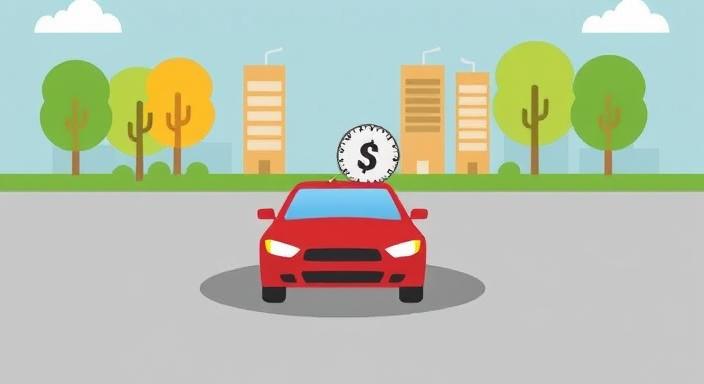The Secret of Car Ownership and Wealth Creation, The hidden cost
Executive Summary:
The Wealth Killer No One Talks About: American Economy shows that owning a car, especially a new one, can hinder your wealth growth.
The article shows how hidden costs can harm wealth building. These costs include depreciation, insurance, fuel, financing, maintenance, taxes, and repairs. These costs also make it harder to invest. It describes the rise of being ‘car poor’ as a significant threat. It offers ways to resist social and industry pressures that lead people to overspend on cars. This overspending can hurt financial growth. 1. The source refers to cars as “the number one wealth killer” for average people.
Expenses such as housing and taxes can change. But, as the author notes, you have more costs to cover these responsibilities. Not possible to remove the adverb.
Total auto loan debt has increased. The hidden cost
- $720 billion in 2005
- $850 billion in 2010
- $1.38 trillion in 2020
- $1.62 trillion in 2025 (record high)
The “Car Poor” Trap. The term “car poor” means you can pay your car payments but struggle to save money.

The condition can feel like “being stuck on a treadmill that never slows,” as one person described it.
Factors That Influence Image and Social Pressure: The car industry spends billions to make buyers believe that new cars can “change your image, build your confidence, and possibly enhance your love life.”” Social pressure adds to this: “Nobody claps when you drive an old Honda that’s paid off… But if you roll up in a new BMW on finance, people [seem to] approve.”
Wanting to appear rich can make people ‘stretch themselves so thin.’ In the end, the car actually ends up owning them,” he said. Negative Equity (Being ‘Upside Down’ on a Loan): This is a serious problem. It happens when people owe more on a loan than what the car is worth. A quarter of the companies were underwater in the fourth quarter of 2023. They expected to owe $40,000 on vehicles valued at only $30,000.” 3.
The High Price The article reveals the “true cost” of owning a car. It points out that the “sticker price” is much different from the actual cost.
For a Honda Civic priced at $27,867, the author explains the total costs over five years of ownership.
5-Year Cost to Maintain a $27,867 New Car (Honda Civic)
- Depreciation: $10,999 (You lose about 10-15% of the value before you even get home.)
That is akin to “paying $2,200 a year for the privilege of watching your money disappear,” the report says.
Insurance: Around $12,000 for a 40-year-old with a clean record. The costs increase for others. Financing: $4,719, with a 10% down payment and 6-6.5% interest; rates can increase to 15-20% for borrowers with poor credit.
A strong credit score matters. Maintenance costs total $3,224. This includes tires, brakes, and oil changes.
DIY maintenance can save money. You can save on DIY maintenance.
Taxes and Fees: Around $2,800 (including road tax). Repairs: $1,790 (unexpected costs beyond regular maintenance).
An emergency fund is essential because “with cars, it’s not if something will break but when.” Total 5-Year Cost: “A Honda Civic, priced at $27,867, will incur a total cost of $46,821 over 5 years.” 4.
The High Price of Opportunity Cost. Opportunity cost is the value of what you give up when you choose one option instead of another.
Every dollar you spend on a car, which loses value, is a dollar not invested in something else. That money could help grow your wealth over time. The report highlights that lost potential gains are often missed. But it has a significant impact on long-term wealth.
Car Ownership or Investment (5-Year Comparison): Pick the Car
: Sell the Honda Civic after 5 years. You’ll get around $19,295. That means a loss of over $27,000 to your net worth.
You could invest and gain more. If you put the $780 monthly car payments into an S&P 500 index fund, you would miss out on potential returns. Over 5 years at a 10% average historical annual yield, this money could grow to about $60,166.
You would end up with $13,000 more in net worth by choosing to invest rather than spend on a car. Wealth difference: Investing and owning a vehicle differ in opportunities. This cost is $40,721. Picking the car instead of an investment means losing potential wealth gains.

Best of the Best Example (Microsoft Stock):
Imagine if you had invested your $46,821 Civic buy price in Microsoft stock five years ago. You would now enjoy a return of 224%.
That means your money would now be over $150,000. Reasons for Lack of Investment: Many people avoid investing due to various reasons. They feel unsure about how to start. But thanks to tools like Trading 212, it’s now much easier. You can invest from your mobile phone. The source notes that owning a car can be expensive. It also states, “In many places, not having a car means losing opportunities.” A Capital One survey revealed that over 66% of people believe owning a car enhances their income. The message isn’t to avoid cars but to consider the situation.
“Car Poor” and Paths to Wealth
The article offers three practical ways to cut car costs. This helps to free up money for investing.
Buy in the “Sweet Spot”: Choose a 3- or 4-year-old car. This way, you can skip the biggest depreciation hit. Additionally, you’ll enjoy modern features, reliability, and a warranty. Warranty that may be intact.
A new car costs $35,000. Currently, the dealer prices this car at $24,000. That’s $11,000 you can invest.
Transportation costs—such as payments, insurance, fuel, and maintenance—can consume up to 15% of your income.
“Anything more surpasses the limit, and you’re at risk of becoming car poor.” Example: If your monthly income is $3,000, your total car expenses should stay under $450. Most people trade in their cars every three to five years, which isn’t a smart move. Instead, buy a car and take care of it. Your financial future relies on it. Possible savings: This approach can save $300 per month, totalling $3,600 over the course of a year. Assuming a 10% annual return, this could exceed $118,000 over 15 years and serve as a potential down payment on a house.

